Kenneth Jackson goes on a few days of speed dating once a year. Don’t worry — the married, 40-year-old father of a 4-year-old isn’t looking for love. Rather, he’s looking for minority-owned broker-dealers with whom he can execute trades for Herndon Capital Management, the asset management firm based in Atlanta where he oversees an estimated $7 billion of the firm’s $10 billion AUM.

The Illinois Opportunity Forum, sponsored by the Illinois Teachers Retirement System, offers what some participants jokingly refer to as speed dating sessions for the asset managers who trade on behalf of the Illinois TRS and the potential brokers looking to execute trades for the $40 billion pension portfolio.
The practice of pension funds using the services of minority- and woman-owned brokerages — called “emerging brokers” in progressive states like California — is not new. For the past two decades, managers of public pension funds have been mandated to use emerging brokers’ services under Directed Brokerage Programs — or face fines and even dismissal if they fail to comply. Since last decade, buyside firms have expanded their pool of brokers to find minority-owned firms that can deliver the liquidity, research and trading tools to execute trades just like the bulge bracket firms. This is more than just lip service for traders like Jackson; as the head trader inside a firm that is owned and operated by African-Americans, Jackson is looking to execute at least 25 percent of his trades with emerging brokers to get the best results and help members in an industry that is still an old-boy network.
It can be a challenge, not because of a lack of talent but rather because of the wealth of minority talent out there. “What’s become increasingly hard is the fact that you can’t do business with everybody. We have close to 40 approved brokers on our platform, and out of that 40 roughly about 10 to 12 are minority brokers,” Jackson told Traders. “Even though it’s a great opportunity to attend the Illinois Opportunity Forum to meet new brokers at various shops, it’s hard because you just can’t do business with everybody.”
He added, “If all of a sudden we add five new minority brokers, then that’s commission dollars that are going away from the existing ones. Are you really helping each minority firm from a commission standpoint to help grow their business?”
Buyside traders like Jackson are not alone when it comes to looking for emerging brokers to help level the playing field. Nanette Buziak, head of equity trading of Voya Investments (formerly known as ING Investments before its corporate rebranding in May), echoes Jackson’s commitment to engage with emerging brokers. “It is important for us as a firm to be supportive of all diversity efforts, from how we recruit talented employees to how we execute our trades,” she told Traders via email.
Right now, Voya uses the services of five emerging/minority-owned brokerages: Guzman & Co., Loop Capital, C.L. King, Sturdivant & Co. and Telsey Advisory Group. “Each differentiates themselves in different ways; some assist us with mandate searches and introductions; others are active in the capital markets; others offer us skilled execution services,” said Buziak.
A New Mandate on the Horizon
Even with Directed Brokerage Programs from public plan sponsors such as the New York State Common Retirement Fund, New York City Retirement Systems and Illinois TRS, among others it can still be a challenge for emerging brokers to get an asset manager’s attention. Donna Sims Wilson, executive vice president of CastleOak Securities, a minority-owned brokerage headquartered in Manhattan, said her firm views directed brokerage programs as an opportunity to make “a warmer call” into an asset management firm to present its capabilities for consideration. “At the end of the day, directed brokerage programs require best execution, and they were really established for minority- and woman-owned brokerage firms that have the capabilities, capital and expertise to add value to that institutional asset management firm,” she told Traders.

“These programs were not established to prop up inferior firms that could not execute,” she said.
And this is set to expand. Under the sweeping Dodd-Frank Act of 2010, a little-known rule called Section 342 could be expanded to push asset managers to use the services of emerging brokers to help level the playing field. In a 2010 speech before the Black Economic Council’s 5th Annual Urban Economic Conference in Oakland, Calif., SEC Commissioner Luis Aguilar explained that Section 342 “contains a clear congressional mandate for the SEC to establish a new Office of Minority and Women Inclusion.” He explained that the then-unnamed director of the OMWI “is tasked with a broad mandate to develop standards: for equal employment opportunity and racial, gender, and ethnic diversity of workforce and senior management; for increased participation of minority-owned and woman-owned businesses in programs and contracts of the agency; and for assessing diversity policies and practices of regulated entities.” In January 2012, the SEC named Pamela Gibbs as the inaugural director of OMWI based in part on her experience as director of the Commodity Futures Trading Commission’s Office of Diversity and Inclusion, where she had served since October 2009.
At press time, the SEC was accepting comments from industry participants on the expansion of Section 342 to mandate asset managers, hedge funds and other buyside firms to trade a certain percentage of their trades via emerging brokers. The SEC and OMWI did not return calls for interviews, and two leading compliance attorneys declined to comment on the forthcoming mandate.
According to Wilson, Section 342 has helped several minority-owned firms participate in the U.S. Treasury Department’s asset sales including the re-IPOs of General Motors, AIG and Allied Financial. “Those are the transactions [in which] minority- and woman-owned brokerage firms have participated as underwriters,” she said.
Jackson joined Herndon Capital in 2012, and he said that the push to use emerging brokers has been a priority since his first day on the job: “I can tell you that when I got here, the message resonated loud and clear that we support minority firms, not through step-out, but by giving them an opportunity to trade.”
And no special favors are given, he added: “We will rank and load on them just like we do the rest of our brokers.”
The Vetting Process
Critics of Section 342 say the rule goes beyond the Dodd-Frank Act’s principal aim of bringing stability and transparency to the financial markets. They charge that Section 342 brings quotas to the financial markets, and conservative critics almost never fail to point out that one of the supporters of the mandate was Rep. Maxine Waters, the African-American Democratic congresswoman from California. In a widely touted editorial entitled “Politicizing the Fed,” The Wall Street Journal wrote that not only is Section 342 the “biggest under-reported threat” of the Dodd-Frank Act, it is also “the most brazen attempt to hijack central bank policy since its founding nearly a century ago.”
The head of one woman-owned brokerage begs to differ. According to Kathleen Cheevers, head of equities brokerage firm Cheevers & Co., “The minorities and the woman-owned firms that are out there now are very professional. They got a bad rap, and I think that’s from 15, 20 years ago. It’s not the way these firms are today.”
While some critics have painted pictures of sham brokerages that have a minority as a straw man, buyside firms are stepping up their broker vetting process to make sure that the emerging brokers are just that: a true minority- or woman-owned enterprise. “Part of our process in vetting emerging brokers is to ask that very question; who owns the firm? What does that individual do there? What is their role?” explained Buziak.
“You would be surprised by the responses you get to those very general questions sometimes,” Buziak added. “The best one I can recall was a broker who said, ‘Well, my wife has a 50.5 percent stake.’ I asked what she does there, and the guy chuckled and said, ‘Nothing, it’s only in her name.'”
Herndon Capital also takes its due diligence seriously. According to Jackson, you want to make sure “that you’re not calling a shoebox with a phone cord.” He recalled a recent trip to visit brokers in New York where he visited one of the minority brokers with which he trades. “It’s one of the things where, outside of our compliance department doing their annual due diligence, we’re going to implement. We’re visiting the offices of not just minority brokers but all of our brokers.”
This is where the speed dating events come in where brokers can answer questions posed by asset managers for major pension funds and endowments. Wilson recalls attending several such sessions for the New York City Retirement Systems and the New York State Insurance Fund. “At Illinois Teachers you sign up and you know exactly who their domestic equity managers, international equity managers and fixed income managers, both domestic and international, are and you request to meet with certain managers. Then they also fill out your dance card,” she said. “I believe there were seven sessions of 10 minutes each.”
Buziak cites Voya’s equally tough but fair broker grading efforts. “We rate our brokers every day with best execution in mind. There is no special treatment for emerging or minority brokers. Some of them hustle harder than our coverage at some of the bulge brackets and we do recognize that,” she said.
Since the economic crisis of 2008, Jackson has noticed an exodus of experienced brokers from jobs at former Wall Street white shoe firms to minority establishments. “Just talk to them and you’ll find out that this person used to work at Lehman Brothers and that person used to work at Bear Stearns or Morgan Stanley. And not just for a couple of years, but they actually were there for 15 years at these bulge bracket firms,” said Jackson. “I think a lot of them are actually having more enjoyment now because it’s not the rat race, so to speak.”
Technology such as high-speed networks, third-party algorithms and trading tools have also leveled the playing field. While a long-only firm like Herndon Capital has no real need for high-frequency trading, these solutions are available from most broker-dealers. “The fact that the majority of them are using Bloomberg data and sellside systems like Fidessa, being able to walk into their shops and see exactly what they’re using is helpful. They all have the fixed connection capabilities to route orders,” said Jackson.
One area where emerging brokers may have a challenge is liquidity. As one broker who asked for anonymity said, “It doesn’t matter if you’re a minority-owned firm, a woman-owned firm, or a white guy who broke out of being with a big firm and wants to do his own thing. The one thing that a larger firm has to offer is the liquidity pool.”
But it all comes down to opportunity. According to Jackson, “The more that we’re supporting firms like that, the more it gives them some of the working capital to improve their technologies and to bring all the best and brightest folks who work on the Street.”



